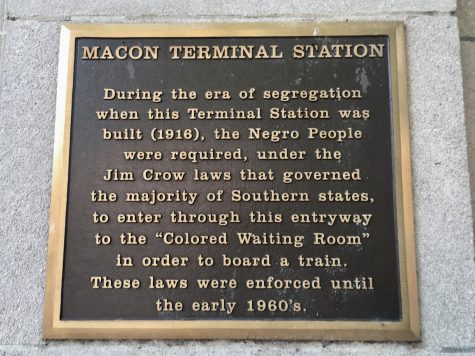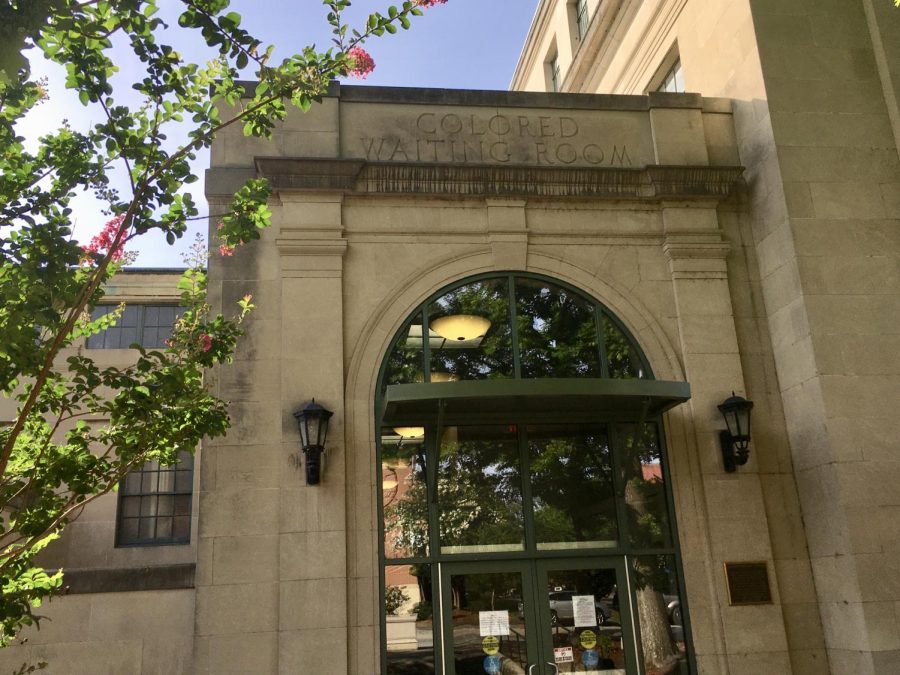Should ‘Colored Waiting Room’ be removed from Macon’s Terminal Station? Black leaders speak out
The “colored waiting room” sign at Terminal Station provides an important history lesson, say Black leaders who want the Macon Transit Authority to preserve it.
Three words etched in limestone at Terminal Station evoke mixed reactions from those who pass by.
The carving of “Colored Waiting Room” over one of the front entrances is an affront to many, but some prominent African American leaders believe it should remain for posterity.
Retired school superintendent Sylvia McGee said her younger relatives learned a difficult lesson during a family reunion years ago.
After touring the Douglass Theatre and the Tubman African American Museum, it was the etching that provoked a rich dialogue about history and Jim Crow laws that cemented a segregated society.
“It was a very organic and rich conversation about their experiences in life and talked about what they experienced and progress they’d seen,” McGee told the Macon Transit Authority Board at its Tuesday night meeting.
The transit authority now manages the 1916 building that was renovated in 2014.
Authority president Craig Ross told the board he gets sporadic calls demanding the sign be erased. Recently, a white man threatened to call in the national news media if it was not removed.
When Georgia Power owned the building, a company sign was placed over the etching.
After the city purchased the building in 2002 for $2 million, Macon‘s first Black mayor, C. Jack Ellis, wanted the sign uncovered for all to see.
As a young man in the 1960’s heading off to join the U.S. Army, Ellis walked under those words to board his train.
He told that story to board members as he advocated to preserve those few words that stung many people who shared his heritage.
The 104-year-old Terminal Station is on the National Register of Historic Places which prevents defacing or making major changes to the structure, but that’s not the reason Ellis insisted it remain.
“It is history. It is a lesson,” Ellis said “It also speaks to how far we have come as a city and as a nation. It’s a constant reminder of how far we’ve come. Not where we are but where we’ve been.”

While mayor, Ellis had a bronze plaque added to the edifice: “During the era of segregation when this Terminal Station was built (1916), the Negro People were required, under Jim Crow laws that governed the majority of the Southern states, to enter through this entryway to the ‘Colored Waiting Room’ in order to board a train. These laws were enforced until the early 1960’s.”
Ross and the authority’s director of business development, Andy Stroud, have conversations about the sign a couple times a year.
“We don’t look at that as a racist statement. We look at it as history and how far we’ve come and it’s going to get better,” Ross told the authority.
With recent civil unrest and protests of Confederal monuments and statues honoring former slave owners, they thought it was a good time to welcome input.
Ellis advocates for the Confederate statue on Cotton Avenue being moved to Rose Hill Cemetery. McGee also recognizes that some monuments “do not embrace or embody equality and justice for all as we attempt to evolve into a more perfect union.”
She suggested the authority establish a “diverse, intergenerational ad hoc commission to have dialogue and invite public input.”
She quoted former Bennett College president Esther A. Terry, who was arrested in Greensboro, North Carolina, after leading a student sit-in to protest Woolworth’s segregated lunch counter: “To eliminate all of the signs of the past can lead to future generations not knowing how far this nation has come and now fully understand the new work that needs to be done.”
McGee feels the authority should preserve and share the entire history of the building from its construction, purpose and legacy.
“Done with intention and purpose, historic sites, such as this Terminal Station, can recognize struggles, foster healing and help the current and future generations make meaning of an era in which they do not personally experience,” McGee said. “Understanding our history can lead towards greater racial justice and equity.”
Ellis reminded the authority that the “Colored Waiting Room” benches have yet to be restored. The larger lobby and waiting area for whites was refurbished to its former glory in 2014.
“I highly recommend we restore that space,” he told the authority.
The former mayor also introduced George Muhammad, who leads historic tours that include a stop to see the Terminal Station sign.
Ellis asked the authority to remove low-hanging tree branches so that the sign could be visible from the street as tour buses come through.
Ross mentioned a new landscaping design is in the works that will likely include removing some trees. Because of the historic nature of the property, the authority will seek approval for the plans from the Design Review Board of the Macon-Bibb County Planning and Zoning Commission before work begins.
Contact Civic Reporting Senior Fellow Liz Fabian at 478-301-2976 or fabian_lj@mercer.edu.











Karen Coates • Aug 7, 2020 at 9:06 pm
I grew up in Macon, Ga coming from Pa. I remember seeing that sign as well as the sign on buses saying “colored passenger seats in rear”. And people certainly don’t need reminders of those days. Remove it & stop trying to justify having it there. What i went through as a child in Macon at Central High was horrible. Just take it down.
Velma Feagin • Jul 23, 2020 at 12:58 am
Hi. A friend and me parked in the Terminal Station lot Saturday (July18,20) after getting face masks given out free.
We were very offended by the writing “colored waiting room” on top of the building. Although it is a part of history, it did not make us feel good_neither did it make a young man passing by feel good_who was not from Macon. I think it would serve a greater purpose in the museum in a section about”segregation”
Thank You
Ms. V. Feagin
Latrina Bryant • Jul 5, 2020 at 7:11 pm
My brother and I started a petition 2 weeks ago through change.org to remove the carving. We think it’s time to stop memorializing a cause that was meant to divide and segregate people of color though we don’t want to erase history but we shouldn’t glorify either. We don’t seek to destroy the history but some make it more inclusive. Some say let It be, why make trouble just accept things as they are…
“Thereare those that look at things the way they are and ask why?I dream of things that never were and ask why not JFK
We will like to propose that the carving be removed and place at the terminal station museum of arts and science and that it will be replaced and renamed Ellen and William Craft South terminal.
Ellen Craft and William Craft were slaves from Macon, Georgia who escaped to the North in December 1848 by traveling openly by train and steamboat arriving in Philadelphia on Christmas day. She passed as a white male planter and he as her personal servant their escape was widely publicized making them among the most famous of fugitive slaves.
Henry David Thoreau said “never look back unless you’re planning to go that way”.
Patty perry • Jul 4, 2020 at 12:57 pm
Best article I have ever read about Macon. Thank you Liz Fabian